Unpopular Music at the End of the Universe
Burning Man as a venue for multi-channel electroacoustic music
UNPOP at The Burning Man Festival 2018
27 August — 1 September 2018
Black Rock City NV, USA
http://unpopularmusic.camp
In 2018 it had been 60 years since the 1958 Brussels World’s Fair was held. 1[1. Exposition Universelle 1958 de Bruxelles, 17 April – 19 October 1958.] The anniversary was celebrated by a special exhibition on the site that invited visitors to “rediscover the magic” of the event. While it doesn’t appear that this included a virtual walk through of the famous Phillips Pavilion collaboration between the architect Le Corbusier, the composer and architect Iannis Xenakis and composer Edgard Varèse, which featured a stunning multi-channel realization of Varèse’s iconic composition Poème électronique 2[2. Although there have been some attempts: see, for example, Lombardo et al 2005.], it did include something intriguing: a special section provocatively titled “The People of ’58.” This apparently included never-before-seen photographs and films of the people who actually attended the event. In the words of one person who relayed a story about his experience walking through the pavilion, “You had to walk slowly because it was dark. And sometimes you’d take a step, and suddenly a sound would appear to be coming from where you stepped, and then would travel through your body and appear above you somehow” (DeWitt 1995). Apparently it was quite frightening, and it would seem that many people were even afraid to enter the pavilion.
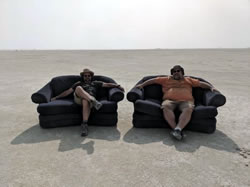
Revisiting these audiences today reminds us that the global audience for multi-channel electronic music has not grown appreciably during the intervening decades. Some of us may be fans of Poème électronique, but unlike those original audiences, we will never know the true nature of the experience, as it was designed to be diffused through several hundred speakers inside a truly bizarre architectural space that no longer exists. Our ability to bring similar works to an audience on a large scale seems to have only diminished over time. This situation reflects a “crisis of venue”, as those of us who love multi-channel electroacoustic music are still, 60 years later, trying to find reliable and consistent ways to present work that requires a controlled listening environment. 3[3. When one includes the work that was being done in Cologne, Paris, Milan and elsewhere throughout the 1950s, the total is actually closer to 70 years!] Besides the film industry, with their blockbuster film temples installed throughout the world, no other industry or artistic constituency has developed a standard presentation facility for multi-channel sound works. Whether this constitutes a “crisis”, of course, depends upon your point of view around standardization and homogeneity, as one cannot deny the positive influence DIY culture has had in sustaining and supporting the “tradition”, as it were, of electroacoustic music. And the prospects of this tradition are being improved by the advent of VR audio, initiating a new generation for whom 3D audio is the norm in virtual and gaming environments, almost certainly creating new enthusiasm around live, multi-channel sound (Titlow 2017). But the fact remains that both conceiving of multi-channel works and then ensuring that they can get more than one good and accurate listening by an audience requires an overhead investment of time, labour and/or money that would not be necessary if the venue question had resolved into an implementable answer sometime in the past seven decades.

Also this year, around the world in the Black Rock Desert of North America, the Burning Man Organization held its 32nd annual event. For those who are not already familiar, Burning Man can be difficult to explain concisely. Essentially, it is a week-long, annual festival of art and music, operating within a “commerce-free” ethical zone, and with agreed-upon social principles that attempt to encourage maximum participation, social responsibility and immediacy of experience while minimizing blind consumption and environmental impact. The event takes place in Black Rock City, a spontaneously formed municipality with a population of over 70,000 people that exists for only a few weeks each year. 4[4. For a good primer on Burning Man, see the organization’s own “First-Timer’s Guide”.]
The authors (Fig. 3) are long-time participants, or “burners”, having attended the event most years since 2003. For us, it has become a place to not only witness and be inspired by a huge amount of interactive artwork, but also a second home, where we participate in the community by sharing our music and art.
As sound artists and composers, we have taken a special interest in the soundscape of Burning Man (Moore and Smallwood 2011) and the impact it has on its inhabitants: the city’s overall sonic structure, the music camps heard both up close and from far away, the sounds made by happy and bewildered people, and the many artworks created by its participants that involve a sound component. We have noted the diversity of artistically crafted sounds available, even as the majority of sounds heard in the city come from beat-oriented music of various kinds. We love this music, but at the same time we have often longed to encounter alternative sonic experiences. Each year, we find ourselves spending much time roaming in the deep Playa 5[5. From the “Glossary” on the Burning Man website: “The Spanish word for beach, also used to describe dry lake beds in the American west such as the Black Rock Desert.” (Accessed 13 March 2019)] where the unintended, aggregate soundscape of the city is at its most interesting. At night, the thousand rumbling beats of the city come rolling across the Playa and form a textured sonic web, ebbing and flowing, and intermingling with soft local sounds: bicycle gears, people laughing softly, the wind, and sometimes ghosts, it seems.
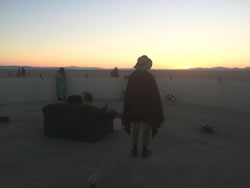
Music itself, of course, is a huge part of Burning Man. Yet while we find participants are endlessly open-minded and have generous attitudes about art and music, this is not necessarily reflected in the diversity of music styles represented there. There are many notable efforts to represent forms of music beyond the club variety, including the Black Rock City Marching Band, Death Metal Karaoke Camp and the growing number of live stage camps (one of which featured a revival of The Alan Parsons Project this year), but there is still a dearth of the more experimental forms of music on the Playa. We have always suspected that we were not alone in our hopes to find other sonic alternatives, and that a space providing such alternatives would be well received.
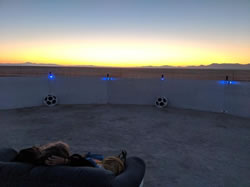
We discussed these thoughts during one long night’s adventure, some years back, as we strolled in the deep Playa at three in the morning, listening as the city’s thunderous beats at conflicting tempi and styles rolled out across the flat floor of the desert, reduced by distance to mostly bass, yet still intricate and layered, with long-unfolding arcs of rhythmic tension and release. All of that complexity coexisted within an inexplicable quiet. As we looked around at other deep Playa wanderers, walking or on bicycles, wandering from one installation to another, we wondered: what if, way out here, under the open night sky, we encountered an intimate electroacoustic venue that was playing multi-channel compositions, field recordings and other sonic interventions throughout the night? The UNPOP or “Unpopular Music” concept was born.
UNPOP: Unpopular Music
Why the name “UNPOP”? The title of our project is a nod to guitarist and daxophonist Mark Stewart, whose biography ends with: “He lives in New York City making his living playing and writing popular music, semi-popular music and unpopular music.” Somehow that comical but apt description of experimentalism seemed like an appropriate frame for the project, so we went with it. It also nicely articulates the idea that the music we would present is not easily pigeonholed into a specific genre, other than the “acousmatic” moniker we tend to use in the electroacoustic community, a term that is virtually unknown and meaningless to those outside of this particular community.
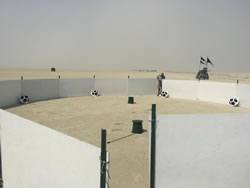
We explained our goal as follows:
UNPOP, or “Unpopular Music”, is an intimate, 8-channel surround sound environment featuring quiet, detailed sounds, including field recordings, abstract electroacoustic music, ambient textures, and other non-beat-oriented sound experiences. For those deep Playa wanderers who are looking for sonic respite and exploration, UNPOP offers a unique program of multichannel sound works that will run from dust until dawn.
The last bit is an insider’s nod to the endlessly dusty environment of the Black Rock Desert. This was the “official” public description of UNPOP that appeared in the Burning Man 2018 art guide, which is part of the packet of information participants are given upon arrival, listing all of the curated artworks, theme camps and timed events. Despite the apparent formality of such a guide, however, it is important to understand that most people don’t seek out specific works intentionally, beyond a handful of well-publicized pieces. Instead, they rely upon more on the power of the random encounter. Participants discover the work, and that discovery becomes part of the narrative of the wandering burner. So, our write-up aimed at being descriptive without being too detailed, understanding that the work would mostly be heard and experienced by people who happen upon it by chance. A big part of the motivation behind our preference to host the UNPOP so far out on the fringes of the event — aside from the quieter environment it would allow — was to allow visitors to make a true discovery, one that takes some work to get to, with the reward being the uncovering of an intimate and unexpected electroacoustic oasis (Fig. 5).
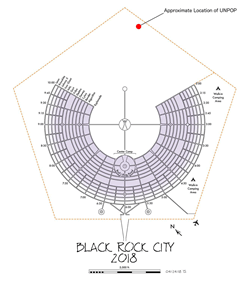
A location positioned at some distance from the city centre was an essential part of our concept. The piece would never work, for example, in the noisy confines of the event’s inner Playa area, which is uncontrollably loud and often traversed by “art cars” carrying enormous club-sized sound systems. In order to be guaranteed this ideal location, we needed to successfully pitch UNPOP to the Burning Man art curation team. Without their blessing, we could have still set up the work, but we would have been taking our chances in terms of the availability of workable spaces. In the end, we were assigned a location way out in the deep Playa that was surrounded by a huge buffer zone of empty space (Fig. 6). This served to prevent our sounds from bleeding into other works (one of their stipulations, as well as our own leanings) and ensured that each piece, even the quieter ones, could be heard in a way that allowed for a full appreciation of its dynamic range.
After deciding upon our approach to the piece and describing it, two big projects remained: building and testing the structure and sound system, and curating a programme of as many diverse, multi-channel electroacoustic works as possible.
Building the Piece
Structure
We knew going in that we wanted a ring of eight speakers that would encircle an intimate environment having a diameter of approximately 50 feet (15 m). This seemed feasible in terms of both the amount of power required and the sonic footprint it would have.
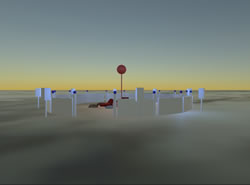
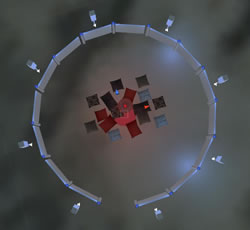
We also felt that some kind of wind protection would be warranted, making the space a bit more of an oasis than it would be if it were installed in open space. We never intended (or could afford) to create an elaborate architectural space, and in the end we even abandoned the idea of any shade structure, opting instead to simply not run the programme during the heat of the day. But the creation of a partially closed structure, allowing for some sound reflections inwards as well as a modicum of protection from the wind for speakers and audience alike, seemed important. To realize this, we devised a scheme based on our previous years of experience in building our own Playa living quarters. We decided to construct a wall made up of 16 segments of 5/16” plywood, each four feet high and eight wide (8 mm, ca. 1.2 x 2.4 m), to encircle the space; the individual segments would be anchored to a six-foot (1.8 m) U-Post driven two feet into the Playa. Pounding in the posts would require a decent amount of physical labour, but we wished to ensure that the structure could withstand the potentially tremendous strength of a dust storm, something that is always a possibility in the Black Rock Desert. We created a 3D model in Unity (Figs. 7 and 8) to test out the feel of the space and then drew up plans to make it a reality.
Sound Equipment
Once we had a basic plan for the structure, we turned our attention to gear. What equipment would be necessary to make this happen? The Playa is notoriously hard on electronics and especially so for electronics with moving parts like fans. Situating the piece so far out in the city meant that it was going to be very far from our camp, so every trip out to check on the piece would be a real effort, and this also factored into our calculations. A robust system that would require as little maintenance as possible became a primary goal. As it turns out, this was warranted, because a round-trip visit to the piece from our camp required walking or biking 4–5 miles (6–7 km), but usually moving against the wind in one direction (driving motorized vehicles is not allowed during the event).
In addition, there is the issue of power. Burning Man does not provide a power grid, so works that utilize electricity require that presenters bring their own autonomous power source. We’ve done a fair amount of work with solar power at Burning Man, notably for KTM (Karmic Teller Machine), an installation piece we have brought to Burning Man every year since 2007 that is completely self-sustaining, running on solar power (Moore, Ogawa and Smallwood 2011; Smallwood and Bielby 2013). However, our calculations showed that UNPOP would tend to require more power than could be reasonably provided via solar generation, given our budget. We opted for a 1400 Watt gas-powered generator, housed in an improvised wooden enclosure and stationed 50 feet (15 m) from the circle. We then worked on the engineering so that both the power draw and the sound contamination typical of gasoline generators were diminished as much as possible.
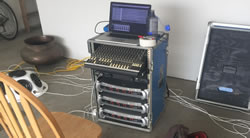

After much discussion and consideration, we decided against attempting to include the possibility of live performance or generative content in this first iteration of the work. Therefore, we only needed to devise a way to play back a lengthy playlist of 8-channel compositions, preferably without having to use a computer. The solution we settled on was the Robertsonics Tsunami board, distributed by Sparkfun. Our model was built into a project box and given some sweet preamp modifications by the noted audio wizard Bob Bielecki. The Tsunami has strict requirements for the formatting of audio files, which translated to a lot of extra pre-processing work that would be added to our preparations. It also meant that separate subwoofer channels were not possible — each of the two subwoofer feeds would be summed from four of the eight channels. But these were compromises worth making, since, once functioning, the board consumed very little power and operated flawlessly.
Would we need a mixer? Even though we were not supporting live performance, we knew there might still be work to do in balancing the channels and making minor EQ adjustments in order to tune the space on site. Having a simple, non-software means of accomplishing that seemed essential. We also needed a way to get the subwoofer channels routed correctly. In the end, we re-commissioned an old but venerable Mackie 1604 mixer with cleverly routed aux sends and direct outs, also donated by Bielecki.
And finally, we had to consider speaker models. We went back and forth on the pros and cons of various brands and types of speakers, understanding that not only would they be fully exposed to the elements for over a week, but they should also be of sufficient quality to warrant all of the other effort that was going into the project. We were mainly concerned about dust, heat and the non-zero probability of rain. Passive speakers seemed like the best option, with separate amplifiers that we could place, alongside the other sensitive electronics, within a big, blue road case rack we acquired through eBay (Fig. 9).
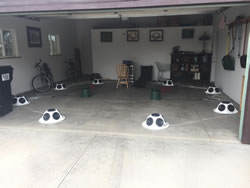
After considering various speaker models, we decided to try the new series of Hemisphere speakers Stephan had just built through his company, Isobel Audio. A special low-albedo white edition of the Hemisphere (Fig. 10) was created for the Playa conditions as a first level of protection against the glare of the daytime sun. Hemispheres were not the decision we thought we would eventually make. For starters — this essentially meant building our own speakers just for this event. Obviously, this gave us more control over the design but was actually much more costly and labour-intensive than purchasing premade speakers with a “regular” design. Secondly, although we both have been long-time users of hemispherical speakers, neither of us expected they would sound good in the traditional round-of-eight configuration we were proposing. But something kept piquing our interest in attempting this scenario. What would it do to the system’s sweet spot to have each channel distributed at a wide angle? Further, how would the circular enclosure wall of the installation interact with eight such signals? The reflection patterns could turn out to be bizarre and unacceptable.
We hoped such a system might allow for a more intimate experience of spatialization, a bit less controlled and more complex. The system still needed subwoofers, and with the added expense of the Hemispheres these needed to be as minimal and as inexpensive as possible, but also able to withstand the weather conditions. For these, we settled on inexpensive green plastic TIC subwoofers, meant to be half-buried in a garden or other outside listening location. We hoped that with help from the circular enclosure wall, they would suffice for rounding out the system’s low end.
We convened about two weeks before the event at the home of Scott’s parents in Colorado, where we had ample room to stage the piece. Days were spent in the backyard, painting the plywood walls in the hot sun. Nights were spent in the garage surrounded by Hemisphere speakers, auditioning the submitted pieces, making sure they were reading properly, designing playlists and setting levels (Fig. 11). Along the way we picked up a pair of comfortable matching blue couches (Fig. 1) at a local thrift store, completing the installation’s physical infrastructure.
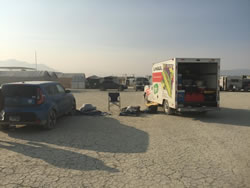
We then rented a truck and carted the piece out to Reno (Nevada) to meet the rest of our crew, and from there onward to Black Rock City (Fig. 12). Our preregistration as artists allowed us, with a small crew, to arrive three days in advance of the start of the event. After being shown our official location on the Playa, we received assistance from the arts services team in digging a trench for the power line from our noisy generator’s enclosure back to the main structure of the piece. Thanks to our friends and favourable weather, we were up and running within a day. Soon after setup, we had the good fortune of withstanding an early, powerful dust storm, which proved to us that our structure’s design would remain rock solid throughout the event.
Curating the Works
The other half of this project, beyond the highly individual character of the sonic canvas we had created, was curating the works themselves. We were extremely fortunate to have received so many pieces to consider, including some newly composed just for this event. We worked right up through our first days on the Playa downloading, editing and getting the playlists together.
In the end, 38 composers are represented in the curated playlists. In this initial voyage, we wanted to feature our own work prominently: works created as individual composers as well as music created under our nearly 20-year musical collaboration, Evidence. These were interspersed in the programme once other works had been selected. Following these initial programme choices, we cast our net widely, choosing not to do a completely open call but rather working within the range of artists whose work we knew and admired, as well others who were recommended to us. We contacted the Canadian Electroacoustic Community (CEC), known for its strong support of a network of young electroacoustic composers, notably through its annual Jeu de temps / Times Play (JTTP) project. We put out a limited call through the network of past JTTP winners and received over a dozen responses with very compelling electroacoustic work attached.
UNPOP was fully operational by nightfall on August 26, a day earlier than planned, because our setup day had gone so smoothly. We decided to play through the first playlist once to make sure no unexpected problems would arise, and then invited our camp mates out for an inaugural celebration and listening party at sunset. To our great relief, the space came alive, and we sat back and just listened with rapt attention to one piece after the next. With that, we were ready to officially open the installation the following evening.
Programme
From nearly 19 hours of music, we crafted three playlists, each 6.25 hours long. Two playlists were played back to back each day, for a total of 12.5 hours of programming per day. After three days, during which each playlist was played twice through, we repeated the entire programme for the next three days.
The works of several composers featured in the complete UNPOP programme that follows can be listened to in Sonus, the CEC’s online jukebox for electroacoustic and related practices. Click on a linked title to go directly to that work or on a linked composer name to view all their works in Sonus.
Programme 1
Scott Smallwood — Cosimo’s Stars
Ian Crutchley — Fontana Mix, September 20th
Alex Yiu — Alter Ego
Jascha Narvesson — Pennsylvania Frogs
Remy Siu — Qanimts (JTTP 2015)
Scott Smallwood — Floe
Elainie Lillios — Hastening Toward the Half Moon
Federico Visi — Unfolding/Clusters
Bill Parod — Lovina Morning
Jon Martin — Open Doors
Evidence — Go Where Light Is
Jascha Narvesson — Doors
Jim Moses — Oscillator Pond: After Dark
Scott Smallwood — Green Stone Cylinder
Sebastien Lavoie — The Four Seasons (JTTP 2014, Cache 2014)
Stephan Moore — A Grid Against the Sky
Vincent Fillion — Stridulations
Scott Smallwood — Grove
Ted Coffey — Petals8
Eli Stine — Murmuration No. 5
Frank Niehusmann — Fragrance
Programme 2
Stephanie Loveless — Some Day
Laurie Radford — Vagus II
Stefan Smulovitz — A Constant Sea
Vanissa Law — Exhaled Rhyme
Scott Smallwood — Wave Passage Effects
Nicole Carroll — In the Liminal Space
Christopher Biggs — New Years
Raylene Campbell — Landing 23
Evidence — Visuals [Render 2]
Nico Arnáez — Electrofuga (JTTP 2014)
Jim Moses — Westminster Street
Luke Dahl — Assessment Postponement Nexus No. 0.5
Matt Test — Bloop
Scott Smallwood — Colton Swarm
Stephan Moore — Toowoomba Looproom: Music of Transmission Damage
Spencer Topel — Syr
Pierre-Luc Senécal — Schrei
Jon Martin — Parallel Windows
Vincent Fillion — Densifications
Bill Parod — Brastagi
Larry Shuen — Partials
Gayle Young — Cascade
Stefan Smulovitz — 68 Paths: Canon
Spencer Topel — Ambient Chaconne
Jon Bellona — Lying in Fireflies Beside Brown Curls
Stephan Moore — Calling Up
Programme 3
Jullian Hoff — Machine in the Shell
Stephan Moore — Dusk in Goa
Scott Smallwood — Slow Heating
Samson Young — Bookshelf Music
Bill Parod — Forest at Raja Berneh
Spencer Topel — Rán
Elainie Lillios — Contemplating Larry
Barry Truax — Earth & Steel
Evidence — Visuals [Render 1]
Matt Test — Viola
Félix Lebrun-Paré — La volonté du périscope (JTTP 2007, Cache 2007)
Jim Moses — Passing Landscapes
Jon Martin — Seven Vignettes (JTTP 2018)
Scott Smallwood — Bull Dozes
Lyn Goeringer — Louhi
Remy Siu — Qanimts (JTTP 2015)
Chris Mercer — The Audible Phylogeny of Lemurs
Sebastien Lavoie — Basketball Glitch
Federico Visi — The Desert Changes
Hildegard Westerkamp — Into the Labyrinth
Bill Parod — Garnet
Spencer Topel — Deus Gratias
Observations and Reflections
Despite many initial worries (wind and dust storms, running out of gas or not calculating the power load properly, uncertainty about the chosen speaker system’s appropriateness for the structure and the music programme, concerns about how the Tsunami board would function, etc.), we ended up being very happy with the way everything performed. The wooden wall structure, simple though it was, held up well and remained solid and silent until we took it down. A minimal solar-powered lighting design served us well. On the exterior, the downward-facing white lights were enough to make the piece minimally visible from afar (Fig. 13), while interior blue LED lighting provided a comfortable and fitting atmosphere. The amplifiers, Tsunami, mixer and other equipment were so unexpectedly energy-efficient that we found we had brought way too much fuel — three times too much!

Perhaps the most unforeseen and most welcome technical aspect of the project was in the sound of the installation itself. The Isobel Hemisphere speakers sounded great, but the spatialization — the ability to hear and feel things move around you wherever you were sitting — was unexpectedly stunning and visceral. In particular, the “sweet spot” area, defined by a well-balanced perception of all of the system’s audio channels, seemed to dilate, such that one could get an accurate sense of the mix when positioned nearly at the walls of the structure. The interaction of the curved walls and wide dispersion angle of the Hemispheres was not, as we had feared, to wash out the sense of space and homogenize the sonic experience within the walls, but to enhance the spatial effects of the independent channels and amplify the perception of space itself, realizing a kind of hyper-reality that many of the pieces we programmed seemed to already be reaching for.
So, technically and physically, the piece worked even better than expected. But how was it received? This was the most gratifying measure of success for us. People seemed absolutely absorbed in the project and we got so much positive feedback that we were not able to keep track of it all. Every time we went out to check on the installation, it was full of people, despite its remote location. We witnessed people happening upon it and staying to listen over and over. Many people related an experience of UNPOP sucking them in and “trapping” them for hours. We even had some people seek us out in our camp and off-Playa after the event, to tell us how much the project meant to them. On the final morning of the piece, as the last music played and we began to tear down the structure, we learned that most of the people there listening that morning had found the piece on a night earlier in the week and had made a point to return to the piece and watch their final sunrise of the event from there (Fig. 14).

Another feature of the UNPOP experience became clear in our conversations with listeners: the wide variety of musical voices and the fairly large scale of it (almost 19 hours of music organized in three curated playlists) meant that each listener’s visit, interacting as it would with the weather and other developments at the event, was potentially highly unique and individualized. People seemed emotionally attached to the work, especially at sunrise. One morning we witnessed a young woman patiently and carefully cleaning dust off the solar cells on the lighting units. We saw people crying and laughing out loud. At one point, I saw a man moving his body gesturally between the speakers in a funny walking motion, kind of oscillating between the speakers as if a sound was bouncing around them. It brought me back to the story organist Larry Dewitt told me back in 1995 (mentioned previously) about how electronic sounds seemed to move through his body as he walked through the Phillips Pavilion.
There was something about the environment, the fact that it was outdoors under the stars, and that it would keep going all night. Having been to many dozens, if not hundreds, of multi-channel EA concerts, mostly at conferences or specific venues, it’s hard to imagine a better venue for multi-channel works than this kind of intimate, outdoor setting. Maybe the idea will spread…
These thoughts return us to the “crisis of venue” mentioned at the outset. Over the 60 years since the Philips Pavilion opened its doors, some things have not changed, but other things have. We may not have solved the problem of how to build a larger audience for electroacoustic work, but through this project we have developed relatively inexpensive, power-efficient, portable and rugged technologies for creating and reproducing multi-channel audio. Sound artists are freer than ever to create multi-channel systems and deploy them wherever they will fit, wherever they find a home. We contend that the “People of ’58” who were so thrilled and baffled by hearing Poème électronique in its strange home are still with us today. That uninitiated audience may be more media-saturated and jaded than their forebears, but they are no less ready or excited to be stunned by the sounds we can create for them, if only we are thoughtful about how we bring them together — what, when, where and how.
Postlude (January 2020)
UNPOP was featured a second year at Burning Man 2019 with an updated roster of artists and will return in 2020, where it will run the entire week on solar energy. UNPOP has also since been featured in Chicago, and will be featured at the Gays Hate Techno (Bay Area) gathering in May 2020.
Replicas of UNPOP would be easy to build and deploy, and we are considering ways that this experience could be shared at other events, with more and different audiences. We hope this report will inspire others to create UNPOPs of their own design, and we look forward to future iterations and collaborations.
Bibliography
Bureau International des Expositions (BIE). “Celebrating 60 Years of Expo 1958 and its Iconic Atomium.” Paris: Bureau International des Expositions, 22 March 2018. http://www.bie-paris.org/site/en/blog/entry/celebrating-60-years-of-expo-1958-and-its-iconic-atomium [Accessed 29 December 2019]
Burning Man Project. “First-Timer’s Guide.” Burning Man Project. http://burningman.org/event/preparation/first-timers-guide [Accessed 29 December 2019]
DeWitt, Larry. Private correspondence. September 1995.
Lombardo, Vincenzo [et al]. “The Virtual Electronic Poem (VEP) Project.” ICMC 2005: “Free Sound”. Proceedings of the 31st International Computer Music Conference (Barcelona, Spain: L’Escola Superior de Música de Catalunya, 5–9 September 2005), pp. 451–454. http://www.cs.bath.ac.uk/~jpff/PAPERS/vep-icmc05.pdf [Accessed 29 December 2019]
Moore, Stephan and Scott Smallwood. “The Soundscape of Burning Man.” Soundscape: The Journal for Acoustic Ecology 11/1 (Fall/Winter 2011) “Crossing Listening Paths,” pp. 47–51. Available at http://www.wfae.net/uploads/5/9/8/4/59849633/soundscape_volume11.pdf [Accessed 29 December 2019]
Moore, Stephan, David Ogawa and Scott Smallwood. “Metafiscal Services in the Middle of Nowhere.” Presented at Radical Aesthetics and Politics: Intersections in music, art and critical social theory (New York: Hunter College, CUNY, 9 December 2011). http://www.scott-smallwood.com/pdf/ktmpaper-FINAL.pdf [Accessed 29 December 2019]
Smallwood, Scott and Jared Bielby. “Solarsonics: Patterns of ecological praxis in solar-powered sound art.” Proceedings of the symposium on Music and Ecologies of Sound: Theoretical and practical projects for a listening of the world (Paris: Université Paris 8, 27–30 May 2013). http://www.scott-smallwood.com/pdf/solarsonics.pdf [Accessed 29 December 2019]
Titlow, John Paul. “Can Spatial 3D Audio Reinvent Live Music?” Fast Company, 5 June 2017. http://www.fastcompany.com/40425973/can-spatial-3d-audio-reinvent-live-music [Accessed 29 December 2019]
Social top